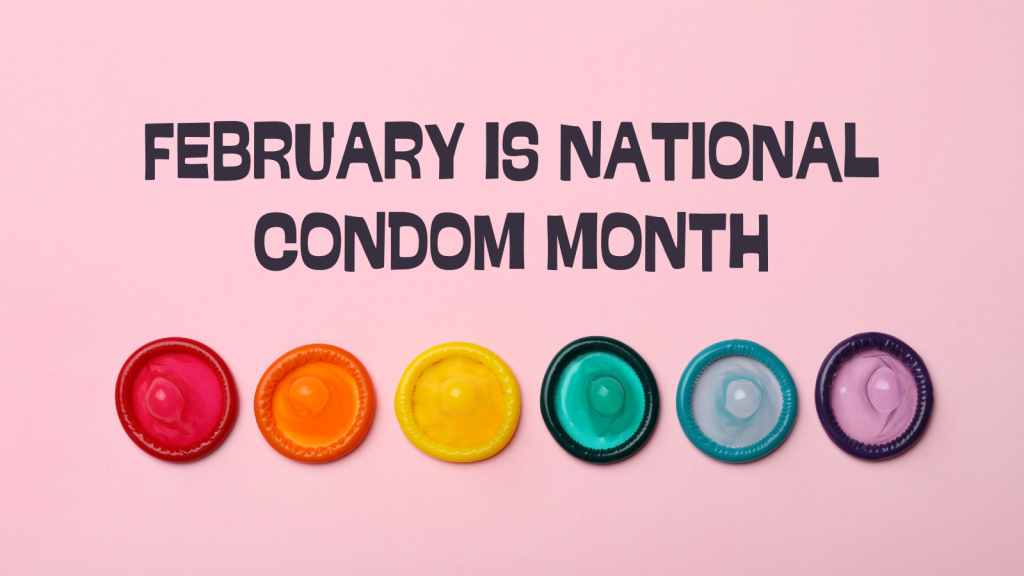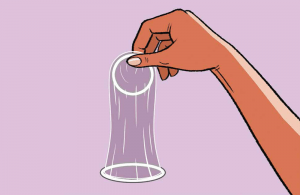
February is National Condom Month. Follow us all month long at #CondomMonth and spread the word about condoms on social media with ASHA with our toolkit.
Currently, condoms are the only widely available, proven method for preventing pregnancy and reducing transmission of HIV and other sexually transmitted infections (STIs) during sex. Condoms work. Condoms work best when you know some basic facts and understand how to use them.
The facts on this page will help you have a better idea of how to use condoms correctly and protect your (and your partner’s) health. You can also download our guide to condoms, offering six great reasons to use condoms and advice for choosing the right condom for you.
External Condoms
External condoms are thin, stretchy pouches that go over the penis to prevent pregnancy and STIs. Cave drawings suggest that the idea of condoms has been around for thousands of years. Early condoms were likely made from animal skins but now we have modern materials like latex, polyurethane, and silicone.
These materials are thin (to let you feel your partner) and strong (to prevent sperm or germs from getting through). Condoms are easy to get, easy to use, and inexpensive. They are the only form of birth control that also protects against STIs.
Condoms Prevent Pregnancy
Condoms provide a strong barrier that prevent sperm from getting into the vagina during penis-in-vagina sex. When used consistently (every time) and correctly (the right way) condoms are 98% effective at preventing pregnancy. Condoms are very easy to use, but people make mistakes. In real world conditions condoms are about 87% effective in preventing pregnancy.
Most condom failure is user failure. Studies have found that people sometimes don’t put on a condom at the beginning of sex, or they take it off too soon. The most common condom failure though—not using one at all. We can’t really blame a condom that’s been left in the night table drawer, can we?
To ensure you get the best pregnancy protection, use a condom every time. Put it on before sex starts and leave it on until after ejaculation.
Condoms Can Prevent STIs
Condoms also provide a strong barrier that even the smallest STI germ cannot get through. Studies have found that condoms are highly effective in preventing HIV. They are also very good at preventing STIs like chlamydia and gonorrhea that are spread through semen and vaginal/cervical secretions. The condom acts as a barrier that prevents you and your partner from exchanging these fluids.
Condoms can also reduce the risk of STIs like syphilis, herpes, and HPV that are spread through skin-to-skin contact when the infected areas are protected by the condom. Condoms can’t provide complete protection for these STIs because sores and warts can appear in places they don’t cover like on the scrotum or the buttocks.
Using a condom is still an important part of STI prevention. Research shows that most HPV infections in men, for example, are located in areas that are covered by a condom. Studies also show that young women who use condoms are much less likely to contract HPV. Using latex condoms can also reduce an individual’s risk of developing HPV-associated diseases such as cervical cancer.
All Condoms Are Tested
Condoms are a Class II medical device which means they are manufactured to strict FDA and industry standards. Condoms undergo rigorous strength testing. In fact, every condom goes through an electrical current test to make sure there aren’t any holes.
Condoms are Easy to Use
The FDA requires some pretty complicated condom instructions inside the box, but anyone who has ever used one knows it’s pretty easy. Check the expiration date (don’t worry, they last a long time), open the package, and unroll it onto the erect penis. It’s that simple.
When you’re done having sex, make sure you or your partner pull outs and takes the condom off pretty quickly. The condom won’t be as tight around the penis once the erection goes down and semen could leak out.
Throw it away and grab a new one if you’re going to have sex again.
It’s that easy.
Condoms are Easy to Find and Inexpensive (or Free!)
The biggest challenge in condom of use may be making sure you have one every time you might need one. But that’s not hard either. Condoms are sold in pharmacies, supermarkets, and convenience stores. They are given out (often for free) at health departments, clinics, and schools. Or you can order in bulk online. Condoms cost about $2 each and—as we said—lots of places give then away for free.
Keep a stash in your night table, another in your purse, some in the bathroom vanity, and a few more in the kitchen (you never know). Have a bowl by the front door. And share with your friend.
Condoms Work Well with Other Birth Control Methods
Some people rely on condoms for contraception and STI prevention. Others use them in addition to another contraceptive method like the pill or an IUD that don’t prevent STIs. Using a condom with another method can provide extra pregnancy prevention and protect you from STIs.
You can also use condoms as a back-up method. For example, some antibiotics have been known to reduce the effectiveness of the birth control pill. If you’re on these medications but feeling better enough to have sex, you can use a condom for added pregnancy protection.
Condoms Can Add to the Fun
Condoms come in many different materials, shapes, and sizes. All condoms on the market are tested and equally effective at preventing STIs and pregnancy, so it’s just about finding the one you like. Pick one with bumps or ridges. Try one that warms or cools. Too tight? Try a bigger size. Too loose? Get one that’s smaller. Want more sensations? Get one that tight at the bottom and loose at the top to give some wiggle room. Allergic to latex? Go for polyurethane. And don’t forget the lube which can make sex slipperier and more pleasurable.
Internal Condoms
 The internal condom is a nitrile pouch that fits inside the vagina. It has a soft ring on each end. The outer, larger ring stays on the outside of the vagina and partly covers the labia (lips). The inner ring fits on the inside of the vagina close to the cervix to hold the condom in place.
The internal condom is a nitrile pouch that fits inside the vagina. It has a soft ring on each end. The outer, larger ring stays on the outside of the vagina and partly covers the labia (lips). The inner ring fits on the inside of the vagina close to the cervix to hold the condom in place.
The internal condom can also be used in the rectum for anal sex. For anal sex, you can use the inner ring or take it out before you insert the condom.
You can put the internal condom in hours before you have sex if you don’t want to have to think about it in the moment.
The internal condom is very effective at preventing both pregnancy and STIs. It covers some additional areas (like the vulva) where STIs might occur.
Using an internal condom is easy, the most important part is to make sure the penis is inserted into the condom instead of to the side of it. (You or your partner can use a hand to guide the penis into the right place.) An internal condom can only be used once. Remove it after sex, careful not to spill any semen inside. Throw it away and get another one.
In the United States, internal condoms are only available by prescription. If you’re interested in using one talk to your health care provider.